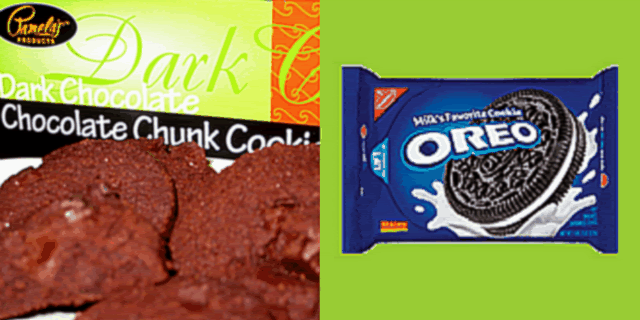In my efforts to seek out sweets that fall under the sensitivity-safe category, I have been met with more than a little skepticism. Those who have not been similarly forced into this way of eating by undeniable changes in their body’s ability to digest certain food substances might wonder, understandably, at the difference between, say, an Oreo cookie and a Pamela’s Dark Chocolate, Chocolate Chunk Cookie. After all, a cookie is a cookie is a cookie, right? Well, with regard to calories and saturated fat content, most often the answer is yes.
But there are some crucial differences between the two aforementioned examples: one of them being high fructose corn syrup (HFCS); and another involving all those crazy food additives and preservatives.
But there are some crucial differences between the two aforementioned examples: one of them being high fructose corn syrup (HFCS); and another involving all those crazy food additives and preservatives.
Now, I spent years as an avid fan of the Oreo cookie; I'm not trying to say they're inherently evil because they contain these things. In fact, they're irresistibly delicious; how could I not enjoy them from time to time throughout my childhood, adolescence, and early adult years? But the whole milk allergy and wheat sensitivity thing kind of ruined that for me.
As a result, I've had to find alternative, more ingredient-mindful indulgences like Pamela's scrumdiddlyumptious assortment of cookies. Lucky for me, when companies take the time to remove the wheat and dairy from their products, they typically leave out the HFCS, too.
But Oreos are not alone. High fructose (a.k.a. "really f***ing sweet") corn syrup is found in just about every processed sweet treat on the market that doesn’t say otherwise, including less obvious things like peanut butter, ketchup, canned fruits and veggies, beans, soups, breads, and yogurt. It has already been linked to a whole slew of health problems—diabetes, heart disease, and obesity being at the top of the list, and I recently read an article chronicling yet another disease-related connection between high fructose corn syrup consumption and the human body. It details the effects of this gooey, corn-based gunk on the liver, as reported by Duke University Medical Center researchers. In a nutshell, they found evidence to support the idea that excess consumption causes liver scarring, or fibrosis.
So aside from causing alarming spikes in blood sugar upon ingestion, its ooze-tastic and chemical-like consistency overwhelms the digestive system, ultimately freaking out your organs and leaving them baffled as to how to process said syrupy sweet stuff. Another way to look at it: It makes you a lot fatter a lot faster, wreaking havoc on your innards along the way.
As a result, I've had to find alternative, more ingredient-mindful indulgences like Pamela's scrumdiddlyumptious assortment of cookies. Lucky for me, when companies take the time to remove the wheat and dairy from their products, they typically leave out the HFCS, too.
But Oreos are not alone. High fructose (a.k.a. "really f***ing sweet") corn syrup is found in just about every processed sweet treat on the market that doesn’t say otherwise, including less obvious things like peanut butter, ketchup, canned fruits and veggies, beans, soups, breads, and yogurt. It has already been linked to a whole slew of health problems—diabetes, heart disease, and obesity being at the top of the list, and I recently read an article chronicling yet another disease-related connection between high fructose corn syrup consumption and the human body. It details the effects of this gooey, corn-based gunk on the liver, as reported by Duke University Medical Center researchers. In a nutshell, they found evidence to support the idea that excess consumption causes liver scarring, or fibrosis.
So aside from causing alarming spikes in blood sugar upon ingestion, its ooze-tastic and chemical-like consistency overwhelms the digestive system, ultimately freaking out your organs and leaving them baffled as to how to process said syrupy sweet stuff. Another way to look at it: It makes you a lot fatter a lot faster, wreaking havoc on your innards along the way.
One of the first times I baked at home, after having gone all organic and allergy-free, my mother asked me what the difference was between using organic cane sugar and the regular stuff. Or, for that matter, buying organic cookies versus regular cookies (e.g., Pamela’s Products vs. Oreos).
Well, aside from the lack of chemical additives and preservatives, organic goodies do not contain a single drop of high fructose corn syrup. They use natural sweeteners like raw cane sugar, evaporated cane juice, agave syrup, stevia, and molasses, to name a few. Again, I’m not operating under any delusions here; products containing these substances will still raise your blood sugar and pack on the pounds if you sit around stuffing your face with them.
As a self-proclaimed sweet-tooth, however, it’s nice to know that I can savor these safely prepared sweets without surrendering my overall health and well-being. And of course, I do take some measure of comfort in knowing that organic was, is, and will most likely always be better and safer for the environment. Unfortunately, for the time being, that means it costs more, too.
But I'm hoping that bit will change.
But I'm hoping that bit will change.



No comments:
Post a Comment